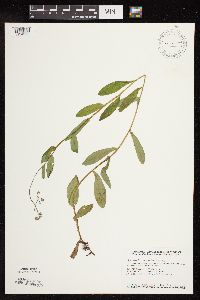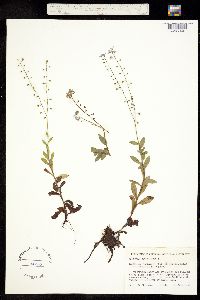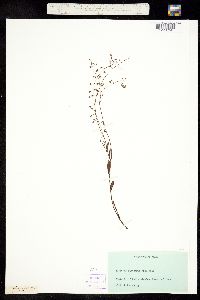Myosotis scorpioides
|
|
|
|
Family: Boraginaceae
True Forget-Me-Not, more...forget-me-not, true forget me not, yelloweye forget-me-not
[Myosotis laxiflora Rchb., moreMyosotis palustris (L.) Hill] |
Perennial herb 20 - 70 cm tall Stem: often creeping and rooting at base, ascending to erect above, loosely branched, succulent, fleshy, angled in cross section, inconspicuously appressed-hairy near base. Leaves: alternate, stalkless, rough with forward-pointing hairs (lowest sometimes also with deflexed bristles on underside), 2.5 - 8 cm long, 0.7 - 2.2 cm wide, oblong or elliptic with blunt tips, though lowest leaves more inversely lance-shaped. Inflorescence: terminal, often paired, somewhat open, one-sided, bractless, appressed-hairy, spike-like branches with coiled tips, and numerous, closely positioned, short-stalked flowers. Flowers: stalked, blue with yellow centers, 0.5 - 1 cm broad, radially symmetric, somewhat funnel-shaped with well-developed tube and shorter, spreading, rounded lobes. The spreading flower stalks are longer than the sepals (3 - 5 mm), and elongate up to 1 cm in fruit. Sepals: five, but fused for over half their length, then separating into five, ascending, triangular to egg-shaped lobes with pointed tips. The calyx as a whole is 3 - 5 mm long, and covered with short, straight, tightly appressed, non-glandular hairs. Petals: five, but fused for over half their length (longer than sepals), then separating into five, rounded, spreading lobes. At the base of the spreading petal lobes, the throat of the petal tube is blocked by five small projections or appendages (fornices). Stamens: five, attached to inside of petal tube by short filaments, the anthers not extending past the petal tube. Pistil: with one, deeply four-lobed, superior ovary; one, relatively long (exceeding sepal tube and nutlets) style; and one, unlobed stigma. Fruit: a cluster of four, fairly erect, shiny, greenish black to black, small (up to 1.8 mm tall and 1.2 mm wide), compressed or somewhat flattened lengthwise, somewhat egg-shaped nutlets with narrowed tips and a prominent lateral ridge running around the edge of the flattened faces. The nutlet clusters are enclosed by the remnant calyx, and held on spreading, up to 1 cm long stalks. Similar species: Myosotis scorpioides is most similar to M. laxa, but that species does not have an angular or fleshy stem, though decumbent at the base the stem never roots, its sepals are fused for only about half their length, the flowers are not as wide (2 - 5 mm), the petal tube is about the same length as the sepals, and the style is shorter than the nutlets and sepals. Our other species of Myosotis have somewhat spreading, hooked, or glandular hairs on their sepals. Flowering: May to October Habitat and ecology: A Eurasian species often planted in gardens and becoming naturalized along streams, in calcareous springy places, and moist disturbed ground, or along bottomlands of rivers. Occurence in the Chicago region: non-native Author: The Field Museum Fibrous-rooted perennial 2-6 dm, often creeping at base and commonly stoloniferous, inconspicuously strigose; lvs 2.5-8 cm נ7-20 mm, the lower mostly oblanceolate, the others more oblong or elliptic to lance-elliptic; infl terminal, becoming open; mature pedicels spreading, about equaling or somewhat surpassing the 3-5 mm cal; cal closely strigose, the lobes equaling or shorter than the tube, sometimes unequal; cor blue, the limb 5-10 mm wide, flat; style equaling or more often surpassing the nutlets, rarely surpassed by them; 2n=64. Shallow water and wet soil; native of Europe, naturalized throughout our range. May-Sept. (M. palustris) Gleason, Henry A. & Cronquist, Arthur J. 1991. Manual of vascular plants of northeastern United States and adjacent Canada. lxxv + 910 pp. ©The New York Botanical Garden. All rights reserved. Used by permission. From Flora of Indiana (1940) by Charles C. Deam Reported by Pepoon as common on the shores of the Calumet River at Clarke, in Lake County. Also reported by Blatchley as an escape in Vigo County, and by Young for Jefferson County. I found a large colony along the St. Joseph River just west of the Elkhart County line. …… Indiana Coefficient of Conservatism: C = null, non-native Wetland Indicator Status: OBL |


























































































